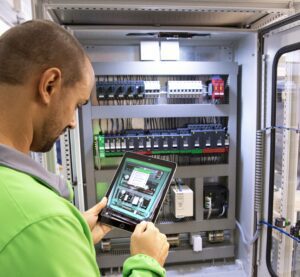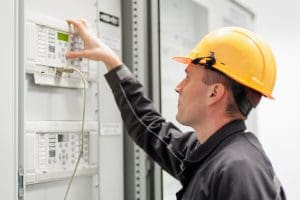Our previous post explained how focused recycling loops enable us to apply a circular-economy approach to our switchgear manufacturing operations. In this post, we discuss how three more of the 5R’s – repair, refurbishing and remanufacturing – have brought circular-economy thinking to several of our other products lines as well.
Everyone is familiar with the idea of wear parts and consumables. For example, automobiles predictably need new tires long before the rest of the vehicle has to be replaced, and even large, embedded components, such as engines and transmissions, often are worth replacing to extend the useful life of the vehicle.
As we began to turn our sights toward supporting a circular economy, rather than a “take, make, dispose” linear economy, we quickly identified our uninterruptible power supply (UPS) product line as a good candidate for repair, refurbishment and remanufacturing.
Not unlike auto tires, UPS units typically have an expected useful life of only three to five years, at which time the battery or batteries need to be replaced even though the rest of the equipment may be in good order. Beyond that, though, technical revisions to both the electronic circuitry and the software upon which it operates are made on an ongoing basis, so after about three years any of our UPS units is likely to benefit from an upgrade, which involves far less than a full system replacement. By selectively upgrading only those components that have become obsolete, we are able to maintain the unit’s highest utility and value without having to start from scratch.
In establishing a service program, we set out to provide users reporting a UPS problem with a replacement unit within four hours. However, this only addressed the service portion of the problem. The question of how to salvage the underperforming equipment remained, whether it was due to battery failure or other problems.
To address this aspect of the problem, we set up a system whereby smaller units are brought to our facility for evaluation and repair. For larger units, a field service engineer is dispatched to replace the affected module and return the malfunctioning module to the repair facility.
Both types of incoming UPS equipment are first sorted to determine their suitability for repair and updating. Equipment determined to be too old or damaged is scrapped immediately. Equipment that can be repaired is sorted, then dismantled and checked for its current revision number and battery condition, and put through specific tests that help the operator determine the root cause of the problem. Specific components, such as the printed circuit board assembly (PCBA), are replaced as needed. Meanwhile, other components – batteries, cables, and so on – are checked to ensure that they can be reused without causing problems. The software is also checked and updated, as needed.
After noting all the upgrades and updates made to the equipment, it is put through the same test regimen as newly manufactured UPS products, ensuring that the refurbished product is entirely up to the latest performance standards.
At that point, the updated UPS products are as good as new and ready for redeployment as other units require replacing. Meanwhile, many of the parts that have been swapped out for new ones, such as the PCBAs, are themselves repaired and placed back into stock as repair parts for future needs. This has the dual effect of reducing waste while also enabling the facility to continue to effectively service older equipment.
Setting up this service loop has had the complementary effect of also giving us the opportunity to repurpose one of our former production facilities, in the southern part of France, as our central UPS service hub. Rather than starting from scratch to establish such a facility, we were able to take advantage of both the existing infrastructure and technical expertise.
That UPS refurbishment facility, established in 2010, this year expanded to begin offering a similar repair/refurbish/remanufacture service for Schneider Electric’s programmable logic controllers (PLCs). We anticipate the launch of a similar refurbishment service for human machine interfaces – HMIs – in the near future.
The next post in the series will discuss in detail our repair services. For more information about how Schneider Electric continues its transformation to a circular economy, please click here.



